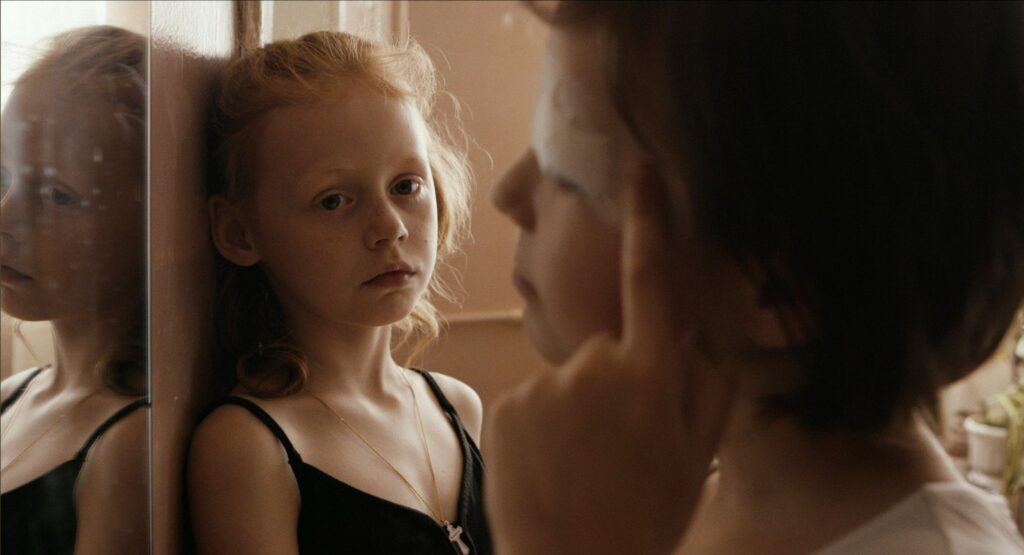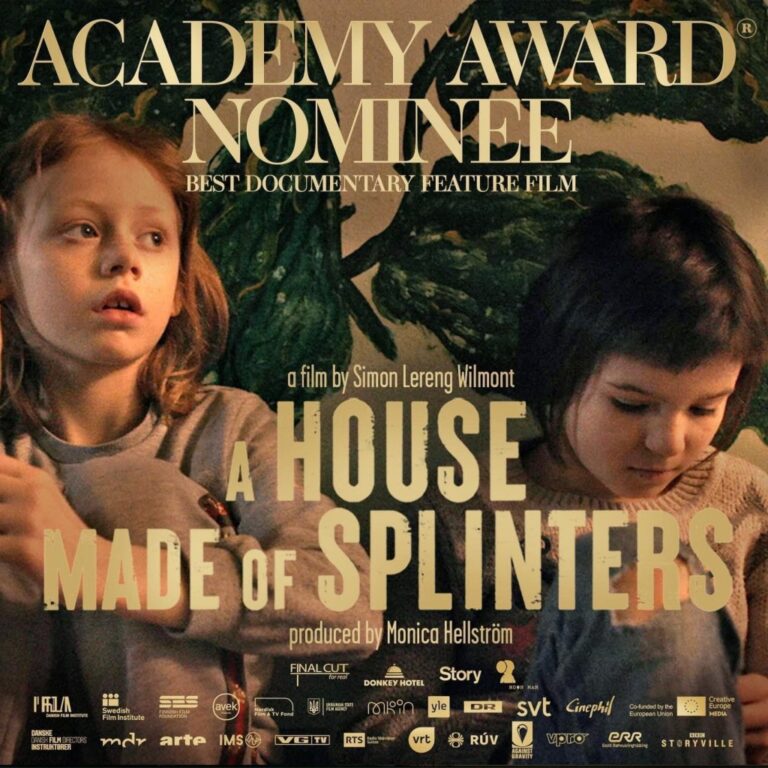A House Made of Splinters – Snapshot
A House Made of Splinters tells the stories of 4 pre-teen kids in a temporary facility for children whose parents, mostly because of alcohol dependency, cannot care for them. The stories are heart-wrenching and too real. Yes, it is filmed in the Ukraine, but it has global reach and should be viewed, especially, in the U.S. (4.5*)
Where to Watch:
Stream: ???
Rent: Prime/Vudu/Google/YouTube ($4); Apple ($5)
A House Made of Splinters – The Oscar Buzz
Oscar Nominations:
Documentary Feature Film
A House Made of Splinters received a single nomination for Documentary Feature Film, putting it in our “special interest” list. Importantly, it is a Ukrainian film and, unless you speak Ukraine, subtitles are required! (This year’s winner in that category was Navalny.)
A House Made of Splinters – The Movie’s Family Tree
The Following Movies Share Talent with This One (and if you like these films, you might like this one):
The Distant Barking of Dogs (17) – Director/Cinematographer (Wilmont); Editor (Aaglund); Sound (Albrechtsen)
A House Made of Splinters is the product of a small team helmed by Simon Lereng Wilmont (Director and Cinematographer). He, like Dosa in last week’s movie (Fire of Love), is a relatively young filmmaker – his first film he worked on only dates to 2004 – and I can’t find anything in his list of works that I have even heard of. By doing some research I learned that his film, listed above, involved the same editor and a key person on the sound team. I’m guessing we will be seeing more of Wilmont’s work!
A House Made of Splinters – What Others Think
A House Made of Splinters, a documentary made in Ukraine, has not had much exposure to American audiences. IMDb based its rating (7.2) on less than 2000 votes, a small number. It was released for theater viewing, a requirement to be an Oscar nominee, at the last possible moment, in February of this year. And has a total box office revenue, worldwide, of just $364. (That’s not a typo!).
The critical Metascore, a respectable 79, is based on only ten reviews when we normally see 60 or 70. I found reviews in RogerEbert.com and New York Times, but critical attention is sparse. Brian Tallerico (RogerEbert.com) noted something I’m going to talk about more below “…the raw moments he captures in this facility are a testament to the trust he clearly built with everyone there…(and) gives his film an undeniable emotional power.” Later he notes “This documentary is so lean in terms of form that it’s sometimes over-reliant on private emotion.” New York Times reviewer Nicolas Rapold observed that “you’re left a sniffling wreck from this compassionate portrait.”
In short, this is an underappreciated movie, mostly because not enough people have seen it. Average ratings end up being good, but as more people see it, I have to believe they will go up!
A House Made of Splinters – Special Mention
Worldwide Alcohol Consumption and Abuse – The children highlighted in this movie are in this home because one or both of their parents have severe problems with alcohol. And although this is about Ukrainian families, I thought it would be interesting to look at the problem from a global perspective. I found several interesting facts, based on the most recent data from the World Health Organization (WHO), published in 2018 based on data collected for the 2016 calendar year. (Note, there are other data sets that reflect slightly different rankings, but they don’t change the conclusions.)
1. Alcohol consumption is measured in the WHO data by liters of pure alcohol per capita per year (converting beer, wine, and spirits to pure alcohol measures). Six of the top ten in consumption are in Eastern Europe and include Estonia (the highest consumer of alcohol with 16.9 liters). But the top ten also includes Seychelles, Germany, Nigeria, and Ireland, so high consumption is not just an Eastern European trait.
2. Alcohol abuse disorder/alcoholism is not the same thing as alcohol consumption and while there is an obvious relationship, it isn’t linear. Significantly, how it is measured is not clearly defined resulting in different sets of rankings, although there are some consistencies. Using WHO data, Hungary comes in at the top of the list with 21.2% of its population afflicted. Russia runs a close second. The rest of the top ten fills in with six more countries in Eastern Europe. South Korea ranks fifth with 13.9%.
3. Ukraine ranks 61st in alcohol consumption with 8.6 liters. But it comes in around fifteenth in alcohol abuse with 2.2%. (The most interesting differences, to me, are where the consumption and abuse rankings are not similar, suggesting different consumption patterns among different population segments.)
4. Just to get a little bit of perspective, and to avoid thinking the picture of Ukraine is especially bad, the United States ranks 46th in consumption with 9.8 liters, more than the Ukraine. But, and I think this is significant, it ranks 6th in alcohol abuse (yep, we’re in the top 10), with 7.7% of the population suffering from the affliction, substantially worse than the Ukraine.
Think of these numbers while watching the film, and and especially think about the comparison between the US and Ukraine – who has the worse problem – and what is happening to our children?
A House Made of Splinters – Michael’s Moments
A House Made of Splinters is a film you should make the effort to see. Yes you will have to rent it from someone and pay a fee. And yes, you will need to deal with captions because it is in Ukrainian, but all of that effort will be repaid many times over.
For crying out loud, it is about children and only the most wretched of us can resist the compelling need to nurture our descendants and to care about what happens to them. But more than that, this film is an intense education for adults who might have only limited access to the thoughts and feelings of young people. A House Made of Splinters shows that they are much more aware of what is happening to them than we assume. Each of these kids knows exactly why they are where they are and they all know that their lives will be changing. They only hope it is for the better. Meanwhile, they do what kids do – capture bubbles in the air, comb a doll’s hair, fight with their friends, and hug them too!
Filmmaker Wilmont puts you right in their faces with closeups where you can see the dirt on their faces and the tears rolling down their cheeks when their Mom doesn’t answer the phone. And the whole time they act as if the camera isn’t even there. It was remarked by one reviewer that Wilmont had somehow managed to gain the trust of everyone to such a degree that they behaved spontaneously and without fear of the consequences. Kolya (a pre-teen boy) cries with his Mother but also smokes a cigarette with his friend and Wilmont captures it all, exposing these kids behavior, and the expression of their feelings, with total truth. It is possible that there were hundreds of times where the kids looked at the camera, or modified their behavior because of its presence, and all of that footage was left on the cutting room floor! But that too shows Wilmont’s integrity in presenting a movie that only shows what the kids felt.
The most boring kind of documentary is the “talking heads” kind where so-called experts tell the camera, and the viewer, what they are supposed to think. There is none of that here – and there is no narrator. A couple of times a staff member does an obvious voiceover, but A House Made of Splinters relies on the kids to tell their own stories and the camera, and the filmmaker, is only there to record them. It is through Wilmont’s skillful cinematography and the amazing editing, that this film becomes more than its parts.
A House Made of Splinters does have a bit of structure to it. The first third of the film tells Eva’s story – hers ends happily as she gets to go home with her grandmother, her mother never even bothering to visit her. Most of the rest of the film bounces between the different intertwined stories of Sasha, and Polina, two maybe 8 year old girls, and Kolya, a 10 or 11 year old big brother who, at that age, has to take care of a younger sister and brother. Sasha and Polina end up going into foster homes, Kolya is separated from his siblings and sent to an orphanage where it appears that he is doomed to a life of delinquency. This is what happens to kids when the parents can no longer care for their children. The movie ends with a scene showing that this is, indeed, a never-ending story!
While the film has a powerful emotional kick, it is also important to consider the context. Yes, it is about kids in Ukraine, far away and part of the Eastern European cultural mess that breeds rampant alcoholism. But, as I tried to outline in the statistics above, we here in the U.S. aren’t any better and, probably even worse. Not only are we in the top ten of countries suffering alcohol addiction (our alcohol abuse rate is 3.5 times that of Ukraine’s), but we also have a serious set of drug dependencies which might involve the same people, or probably many more. (My daughter had her newborn baby taken from her because the baby tested positive for drugs!) What are our intermediate solutions between dissolved families and rehoming solutions? Are they any better than in A House Made of Splinters? Or, as I suspect, are they even worse? What are the stories of our children?
A House Made of Splinters fires on all cylinders and meets all the criteria for a good documentary – Story, Craftsmanship, Integrity, and Effort. It also lives with you – it is very hard to get these kids stories out of your head. A documentary is supposed to educate you but it is a double success if it also makes you feel – this one does both. I dare you to watch it! (4.5*)


